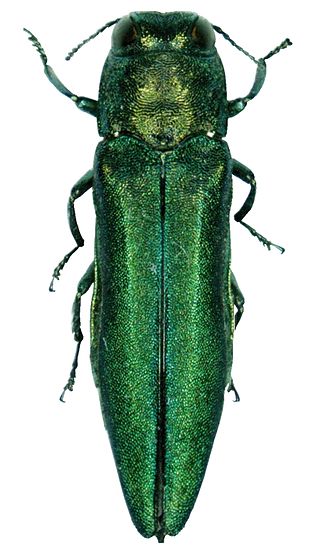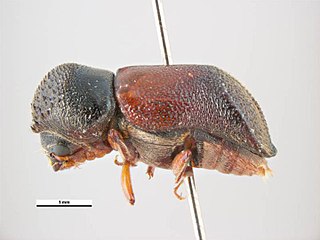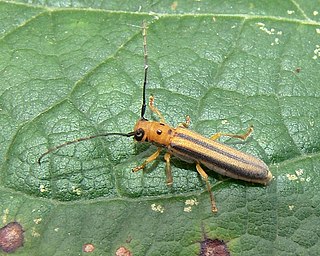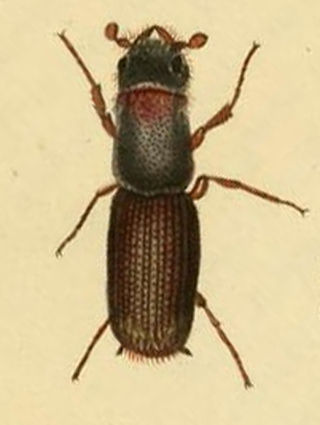
The Asian long-horned beetle, also known as the starry sky, sky beetle, or ALB, is native to the Korean Peninsula, northern and southern China, and disputably in northern Japan. This species has now been accidentally introduced into the eastern United States, where it was first discovered in 1996, as well as Canada, and several countries in Europe, including Austria, France, Germany, Italy and UK.

Bookworm is a general name for any insect that is said to bore through books.

A woodworm is the wood-eating larva of many species of beetle. It is also a generic description given to the infestation of a wooden item by these larvae.

The emerald ash borer, also known by the acronym EAB, is a green buprestid or jewel beetle native to north-eastern Asia that feeds on ash species. Females lay eggs in bark crevices on ash trees, and larvae feed underneath the bark of ash trees to emerge as adults in one to two years. In its native range, it is typically found at low densities and does not cause significant damage to trees native to the area. Outside its native range, it is an invasive species and is highly destructive to ash trees native to Europe and North America. Before it was found in North America, very little was known about emerald ash borer in its native range; this has resulted in much of the research on its biology being focused in North America. Local governments in North America are attempting to control it by monitoring its spread, diversifying tree species, and through the use of insecticides and biological control.

The deathwatch beetle is a species of woodboring beetle that sometimes infests the structural timbers of old buildings. The adult beetle is brown and measures on average 7 mm (0.3 in) long. Eggs are laid in dark crevices in old wood inside buildings, trees, and inside tunnels left behind by previous larvae. The larvae bore into the timber, feeding for up to ten years before pupating, and later emerging from the wood as adult beetles. Timber that has been damp and is affected by fungal decay is soft enough for the larvae to chew through. They obtain nourishment by using enzymes present in their gut to digest the cellulose and hemicellulose in the wood.

Powderpost beetles are a group of seventy species of woodboring beetles classified in the insect subfamily Lyctinae. These beetles, along with spider beetles, death watch beetles, common furniture beetles, skin beetles, and others, make up the superfamily Bostrichoidea. While most woodborers have a large prothorax, powderpost beetles do not, making their heads more visible. In addition to this, their antennae have two-jointed clubs. They are considered pests and attack deciduous trees, over time reducing the wood to a powdery dust. The damage caused by longhorn beetles is often confused with that of powderpost beetles, but the two groups are unrelated. The larvae of the Cerambycidae are white, straight and generally flat-headed, whereas those of the Bostrichidae are white and C-shaped.

The term woodboring beetle encompasses many species and families of beetles whose larval or adult forms eat and destroy wood. In the woodworking industry, larval stages of some are sometimes referred to as woodworms. The three most species-rich families of woodboring beetles are longhorn beetles, bark beetles and weevils, and metallic flat-headed borers. Woodboring is thought to be the ancestral ecology of beetles, and bores made by beetles in fossil wood extend back to the earliest fossil record of beetles in the Early Permian (Asselian), around 295-300 million years ago.

Hylotrupes is a monotypic genus of woodboring beetles in the family Cerambycidae, the longhorn beetles. The sole species, Hylotrupes bajulus, is known by several common names, including house longhorn beetle, old house borer, and European house borer. In South Africa it also is known as the Italian beetle because of infested packing cases that had come from Italy. Hylotrupes is the only genus in the tribe Hylotrupini.

Ptinidae is a family of beetles in the superfamily Bostrichoidea. There are at least 220 genera and 2,200 described species in Ptinidae worldwide. The family includes spider beetles and deathwatch beetles.

The wharf borer, Nacerdes melanura, belongs to the insect order Coleoptera, the beetles. They belong to the family Oedemeridae, known as false blister beetles. Wharf borers are present in all the states of the USA except for Florida. It takes about a year to develop from an egg to an adult. The name 'wharf borer' comes from the larval stage of this insect, which often lingers on pilings and timbers of wharves, especially along coastal areas. The adult beetles are identifiable via a black band across the end of both elytra. In addition, wharf borers are distinct from other members of the family Oedemeridae due to the presence of a single spur on the tibia of the forelegs and the distance between both eyes. The female beetle oviposits eggs on rotten wood, on which the larvae hatch, burrow, then feed. Adults do not eat and depend on stored energy reserves accumulated as a larva. They are considered a pest because they damage wood used in building infrastructures.
Home-stored product entomology is the study of insects that infest foodstuffs stored in the home. It deals with the prevention, detection and eradication of pests.

Xylopsocus gibbicollis, common name "common auger beetle", is a species of beetle of the family Bostrichidae.

Lyctus carbonarius is a wood-boring beetle in the family Bostrichidae, commonly known as the southern lyctus beetle or lyctid powderpost beetle. It is a serious pest of hardwoods including ash, hickory, oak, maple and mahogany and can infest many products in the home including hardwood flooring and structural timbers, plywood, furniture, tool handles, picture frames, baskets and ladders. Timber can be infested in one location and then be transported large distances by ship, after which the beetles can emerge and spread the infestation to new areas.

Oberea tripunctata, the dogwood twig borer, is a species of longhorn beetle that is a widespread pest that attacks dogwood trees.

Platypus apicalis, known by its common name the New Zealand pinhole boring beetle, is a wood-boring beetle endemic to New Zealand and found throughout the North and South Island in a range of environments.

Xylosandrus compactus is a species of ambrosia beetle. Common names for this beetle include black twig borer, black coffee borer, black coffee twig borer and tea stem borer. The adult beetle is dark brown or black and inconspicuous; it bores into a twig of a host plant and lays its eggs, and the larvae create further tunnels through the plant tissues. These beetles are agricultural pests that damage the shoots of such crops as coffee, tea, cocoa and avocado.

Platypus cylindrus, commonly known as the oak pinhole borer, is a species of ambrosia beetle in the weevil family Scolytinae. The adults and larvae burrow under the bark of mature oak trees. It is native to Europe.

Dendroctonus terebrans, the black turpentine beetle, is a species of bark beetle native to the eastern United States. Its larvae tunnel under the bark of pine trees, weakening and sometimes killing the trees.

Oemona hirta, the lemon tree borer, also known as the whistling beetle or the singing beetle, is a longhorn beetle endemic to New Zealand. Its larvae are generalist feeders, boring into the wood of a wide variety of trees, native and introduced. When citrus orchards were first established in New Zealand, this beetle started inflicting serious damage, and so gained the name "lemon tree borer". Four species within the genus Oemona have been identified, suggesting that more species could be found. When disturbed by predators or humans, the adult beetle stridulates creating a "rasp" or "squeak" sound by rubbing its thorax and head together against an area of thin ridges. Māori would eat a liquid called "pia manuka", which was produced by manuka trees when its wood was damaged by the larvae. When Captain Cook first arrived in NZ, his naturalists, Banks and Solander, collected a lemon tree borer in their first collection between 1769 and 1771. This oldest collected specimen can be found in the British Museum. A few years after the first collection, the species would be first described by the Danish naturalist Fabricius in 1775.

Arrenodes minutus, commonly known as the oak timberworm, is a species of primitive weevil in the family Brentidae. These beetles are pests of hardwoods in North America. Adult oak timberworms are shiny, elongate, and range 7 to 25 mm in length. They are reddish-brown to brownish-black in coloration, with yellow spots on their elytra. Adults display strong sexual dimorphism; females have long, slender, straight mouthparts, while males possess flattened, broadened mouthparts with large mandibles. Males are known to be aggressive and use these large mandibles for combat. These mandibles are also used in courtship. Larvae are elongate, cylindrical, white, and curved. They have 3 pairs of jointed legs on the thorax and 1 pair of prolegs near the end of the abdomen.





















